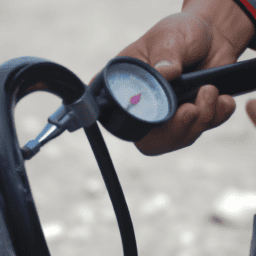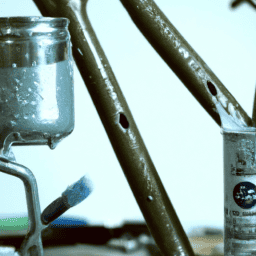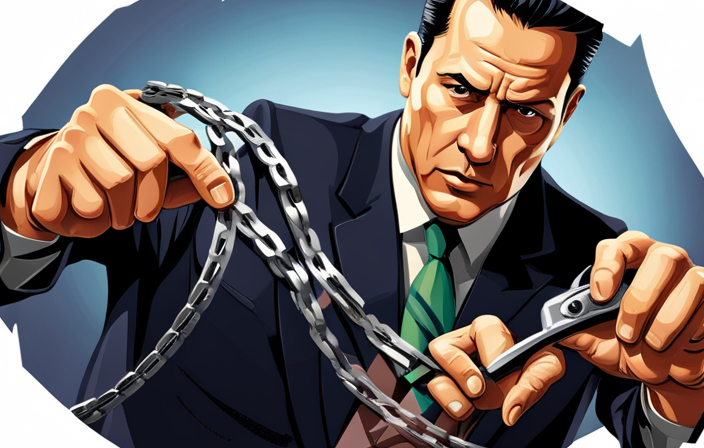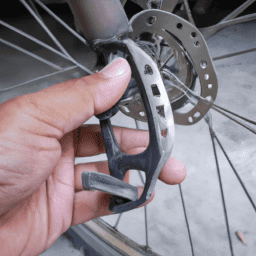For cyclists, ensuring a seamless and secure journey involves consistently inspecting and inflating your tires. Maintaining the correct tire pressure enhances the comfort of your ride, aids in the avoidance of punctures, and betters the control over your bicycle.
In this article, I will guide you through the steps of how to pump up your bicycle tires. First and foremost, it’s crucial to check your tire pressure before pumping them up. Different types of tires require different pressures, so it’s important to check the recommended pressure for your specific tires. You can typically find this information on the sidewall of your tire or in the owner’s manual that came with your bike.
Once you know the recommended pressure, gather your tools, which will include a bike pump with a pressure gauge and a valve adapter if your pump doesn’t fit your valve. With these basics in hand, you’re ready to start inflating your tires.
Key Takeaways
- Regularly check and inflate bicycle tires to improve handling and prevent flats.
- Use a bike pump with a pressure gauge and valve adapter if necessary to ensure proper tire pressure.
- Underinflated tires can lead to poor handling, decreased fuel efficiency, and blowouts.
- Proper inflation is crucial for a smooth and safe ride, and checking tire pressure only takes a few seconds.
Check Your Tire Pressure
Don’t forget to grab a tire pressure gauge and give those tires a quick squeeze before hitting the road! Checking your tire pressure is crucial for a safe and smooth ride. The importance of pressure cannot be overstated – underinflated tires can lead to poor handling, decreased fuel efficiency, and even blowouts. On the other hand, overinflated tires can make for a bumpy ride and increase the risk of punctures.
So, how do you know if your tires are underinflated? Signs of underinflation include a sluggish feel while riding, decreased maneuverability, and a lower top speed. Additionally, the tire may appear flatter than usual, and the rim may be in contact with the ground when the bike is stationary.
Checking your tire pressure only takes a few seconds, and it’s an easy way to ensure a safer and more comfortable ride. Once you’ve checked your pressure, it’s time to gather your tools.
Gather Your Tools
When it comes to gathering the tools needed to pump up your bicycle tires, there are a few key points to keep in mind. First and foremost, you’ll need to choose a bike pump that’s appropriate for your needs.
Depending on the type of valve on your tires, you may also need to invest in a valve adapter. Additionally, if you’re someone who frequently finds themselves needing to inflate their tires on the go, you may want to consider investing in a portable pump.
Gather your tools.
Choose a bike pump
To ensure you’ve got the right tool for the job, it’s important to choose a bike pump that’s compatible with your bicycle tires.
There are a few different types of bike pumps to choose from, each with their own pros and cons.
First, there are floor pumps. They are the most common type of bike pump and are large and sturdy. They usually stand on the ground while you pump and are great for home use because they can quickly inflate a tire to the desired pressure. However, they are not very portable and may be too large to carry on a bike ride.
The second type of pump is the frame pump. It is smaller and can attach to your bike frame. These pumps are more portable than floor pumps, but they take longer to inflate tires and may not be powerful enough for larger tires.
It’s important to note that some bikes may require a specific type of pump, such as a high-pressure pump for road bikes.
When choosing a pump, consider the type of riding you will be doing and the size of your tires. Once you’ve got the right pump, you can move on to the next step and get a valve adapter if necessary.
Get a valve adapter if necessary
You absolutely need a valve adapter if your bike tires have a different valve than your pump can handle. Valve adapter compatibility is important because it ensures that the pump can fit onto the valve and properly inflate the tire.
Different types of valves require different types of adapters, so make sure to check the compatibility before purchasing. If you don’t have a valve adapter, there are alternative valve options for your bike tires.
Some pumps come with multiple valve attachments, allowing you to switch between valve types. Additionally, some bike tires come with removable valve cores, which can be replaced with a different type of valve core.
However, it’s important to note that not all valve cores can be replaced, so check with your bike manufacturer before attempting to switch valves. Considering these valve options can help you avoid the hassle of needing a valve adapter.
Now, let’s consider a portable pump for on-the-go inflation.
Consider a portable pump for on-the-go inflation
If you’re someone who loves to cycle long distances, it’s important to have a portable option for inflating your tires on the go. The last thing you want is to be stranded with a flat tire in the middle of nowhere. Portable pumps are a great solution for this problem, and they come in a variety of styles and sizes to fit your needs.
Here are some benefits of using a portable pump and some of the best brands on the market:
-
Benefits of CO2 cartridges: CO2 cartridges are a popular option for portable pumps because they’re small and lightweight. They also inflate your tires quickly, so you can get back on the road faster. However, they’re more expensive and can only be used once.
-
Best portable pump brands: Some of the best brands on the market include Topeak, Lezyne, and Blackburn. These brands offer a variety of pumps that are small and portable, yet powerful enough to inflate your tires quickly and efficiently.
-
Types of portable pumps: There are two main types of portable pumps: hand pumps and CO2 inflators. Hand pumps are small and lightweight and can be used multiple times. CO2 inflators are small and fast, but they’re more expensive and can only be used once.
-
Features to consider: When choosing a portable pump, consider the size, weight, and compatibility with your bike’s valve. Look for pumps with a flexible hose, gauge, and a secure attachment to your bike frame.
Having a portable pump can save you from a lot of headaches on your cycling adventures. But it’s also important to know how to inflate your tires properly, which we’ll cover in the next section.
Inflate Your Tires
First things first, make sure your tires are properly inflated. Can’t ride with flat tires! To inflate them, you’ll need a pump. It’s important to use the proper technique to avoid common mistakes.
To start, remove the valve cap from your tire and attach the pump nozzle to the valve. Make sure the nozzle is tightly secured to the valve to prevent air from leaking out.
Next, use smooth, even strokes to pump air into the tire. Keep an eye on the tire pressure gauge to ensure you’re inflating it to the recommended pressure. Overinflating or underinflating your tires can lead to poor traction, decreased control, and increased risk of punctures.
When you’ve reached the correct pressure, remove the pump nozzle from the valve and replace the valve cap. Finally, check your work by giving the tire a quick squeeze to make sure it feels firm.
Remember, proper inflation is crucial for a smooth and safe ride, so take the time to properly inflate your tires before hitting the road.
Check Your Work
Now that your tires are properly inflated, it’s time to check your work and make sure they’re ready for a smooth and safe ride. The importance of pressure cannot be overstated when it comes to bicycle tires.
You need to ensure that both tires have the same pressure level. This will help you maintain balance and control while riding. Consistency in checking is also crucial.
You don’t want to find yourself with underinflated tires while you’re on the road. It’s recommended that you check your tire pressure before every ride. If you ride frequently, it’s advisable to check your tires once a week.
Lastly, keep in mind that maintaining proper tire pressure is key to maximizing the lifespan of your bike’s tires. With these tips in mind, you can now maintain proper tire pressure and ensure that your bicycle tires remain in good condition.
Remember, it’s always better to be safe than sorry.
Maintain Proper Tire Pressure
To ensure smooth and safe rides, it’s crucial to maintain the correct pressure level in your bike’s tires. The benefits of proper inflation are numerous: it allows for better handling, reduces the risk of flats, and extends the lifespan of your tires.
When you ride with tires that are properly inflated, you’ll notice that your bike feels easier to steer and control. This is because the tires have the optimal amount of contact with the road surface. Additionally, the chances of getting a flat tire due to pinch flats or punctures are greatly reduced when the tire pressure is correct.
Finally, by keeping the tires at the right pressure, you’ll make them last longer, which will save you money in the long run. Conversely, the consequences of underinflation are equally significant. When a tire is underinflated, it’s more prone to damage from road hazards, such as potholes and debris.
The lack of pressure also causes the tire to deform, which increases rolling resistance and makes it harder to pedal. This can lead to a decrease in overall performance, making it harder to reach higher speeds and making the ride feel less comfortable. Underinflation also causes the tire to wear unevenly, which can lead to premature failure.
Ultimately, neglecting to properly inflate your bike’s tires can result in a dangerous riding experience, so it’s crucial to maintain the correct pressure level at all times.
Frequently Asked Questions
What is the recommended tire pressure for different types of bicycles?
When determining the recommended tire pressure for a bicycle, factors such as the rider’s weight and the type of terrain should be considered. To measure tire pressure accurately, use a pressure gauge.
How often should you check your tire pressure?
Checking tire pressure regularly is crucial for optimal bike performance. Neglecting it can result in decreased speed, difficult handling, and increased risk of flats. Signs of low pressure include sluggishness and irregular tire wear.
Can you use a regular air compressor to inflate your bicycle tires?
Yes, air compressor alternatives exist to inflate bicycle tires. Pros include convenience and speed, while cons include potential damage to tires and difficulty controlling pressure. Be sure to use a pressure gauge and follow manufacturer guidelines.
What are some common causes of tire punctures and how can they be prevented?
Punctures are a common problem with bicycle tires. To prevent them, I recommend using tire liners and sealants. Additionally, choosing the right tire tread for your riding conditions can greatly reduce the likelihood of punctures.
What should you do if your tire pressure is consistently low even after inflating it?
If my tire pressure is consistently low even after inflation, troubleshooting includes checking for punctures, valve leaks, or rim damage. If I can’t find the issue, I should seek professional help.
Conclusion
In conclusion, it’s essential to maintain proper tire pressure to ensure a safe and comfortable cycling experience. Checking your tire pressure with a gauge before each ride is crucial, as well as having the necessary tools to inflate your tires if needed. Remember to always inflate your tires to the recommended pressure level, which can be found on the sidewall of your tire.
Now, imagine you’re cruising down a winding road, feeling the wind in your hair and the sun on your face. Suddenly, you hear a hissing sound and feel your bike slowing down. You pull over to the side of the road and realize you have a flat tire. You start to panic, wondering how you’ll get back home or to the nearest bike shop.
But wait! You remember the steps you learned to pump up your tires. With confidence, you take out your tools, check the tire pressure, inflate the tire, and check your work. Within minutes, you’re back on the road, enjoying the ride again.
Knowing how to pump up your bicycle tires can save you from a stressful situation and keep you cycling safely and happily.









